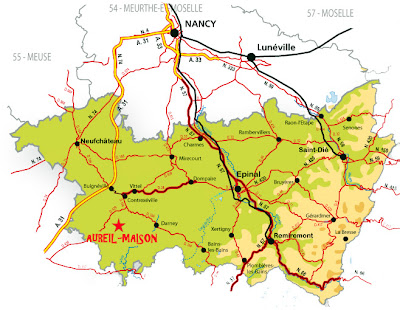The little hamlet Aureil-house, located two Lamarche not, it depends on, has retained a beautiful Romanesque chapel in large part, and is dedicated to the Virgin.
Historical
The first mention of the chapel dates from 1043 when the Bishop of Toul, Bruno Dabo (1026-1051) endorsed the establishment of the priory Deuilly. Indeed, we learn that the small monastery then held half of the church Aureil-House ( mediatatem ecclesiae of Aurelii mansionibus ). What do we know when the building in the middle of the eleventh century? Not much, it would in any case be small, perhaps in drink!
From the mid-twelfth century, the chapel was rebuilt Romanesque, starting with the choir and continuing through the nave.
In 1188, the Bishop of Toul, Peter Brixey (1168-1191) confirmed that the chapel Aureil-house was well within the Priory of Deuilly, whose prior appointed the parish priest. In 1195, Pope Celestine III (1191-1198) validation of this new possession Deuilly.
After the twelfth century there was little information on the history of the building. There is, however, that the church has undergone few changes. In the likely collapse of the Romanesque bell tower (located above the front-chorus) at an unknown date, it was not rebuilt, and the nave and the choir were pre-coated with a single roof. So devoid of steeple, the municipality had placed during the nineteenth century, a wooden steeple at the base of the door.
Finally, since March 3, 1926, the chapel is listed in the inventory of historical monuments.
architecture and statuary
In his great work, the chapel Aureil-house dates from the second part of the twelfth century. The choir with its span remains the oldest part because can be dated to around 1150. The nave appears later, from the far end of the twelfth century or early thirteenth century.
From the outside it has a nice view from the esplanade and you notice immediately the unusual wooden turret added later above the door. Walking around the building, one can notice the presence of three arched Romanesque windows splayed on the north and south walls. The sanctuary consists of a simple semi-circular apse with a decorative arched arcades. The west facade has a Romanesque fairly simple semicircular arches falling on columns with flared capitals and lanceolate; as a tympanum, a modern stained glass tracery was placed under the Roman arches. But was there a stone tympanum behind? Impossible to say but some, like Hubert Collin, a specialist in Roman art Lorraine doubt this assumption.
Inside the building, the nave welcomes us in all its simplicity, it is limited like many other Romanesque churches in Lorraine. Indeed, it is not uncommon to find, at a time when the stone vaulting is democratized, churches with flat ceiling with wooden slats. Passed the nave, which is not unique, it comes before the triumphal arch semicircular broken giving access to pre-chorus chorus preceding the semi-circular. Note the transom trim the twisted right wall of the triumphal arch.
Upon entering the front-chorus (supporting the Romanesque bell tower collapsed), it is grasped by the simple beauty of the ribbed vault. We discover also placed against the wall, the ancient burial to end cross (fourteenth century) belonging to a knight, it was originally located in the middle of the nave by a statement made by Georges Durand in the early twentieth century.
The choir has a novel setting of five arches arches based on five columns with foliage and ribbon. In the middle of this arch, above the altar and on a pedestal, a Virgin and Child in the woods late twelfth century or early thirteenth century, stands proudly, only the Child Jesus is mutilated ( it lacks the head and his left hand).
Place the photos now ...
___________________________________
Situation Aureil-house hamlet in the Vosges
Location of the chapel in the hamlet
_______________________________
The Chapel from the south-west, with its wooden steeple
The sanctuary with its semicircular apse
Bedside - The semi-circular apse Romanesque
with semicircular arches
Nave - The south wall with three arched Romanesque windows splayed
The nave - Romanesque capital to ram heads embedded in the corner Southwest
Portal novel semicircular stained glass tracery
as a tympanum
The nave ceiling and choir novels
Triumphal Arch Roman semicircular broken
separating the nave from the choir
Right side of the triumphal arch - The transom trim twisted
The pre-chorus and chorus
The pre-chorus - The ribbed vault
The choir and its arched open hanger
Choir - Romanesque capital foliage
Choir - Marquee novel leaves and ribbon
Choir - Madonna and Child Wood
(late twelfth century or early thirteenth century)
tombstones with crosses pattee
(fourteenth century)
Copyright - Olivier PETIT - 2011


























0 comments:
Post a Comment